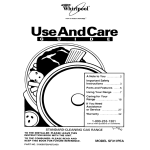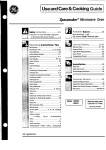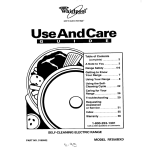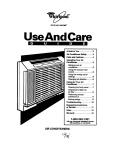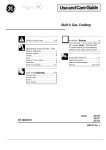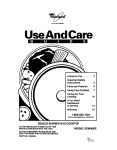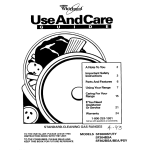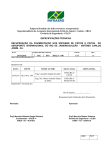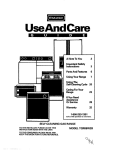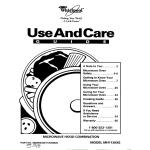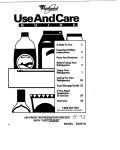Download Whirlpool SF317PCA Specifications
Transcript
UseAndCare C A Note To You 2 kiiZit2~:a 3 Parts And Features 6 Using Your Range 7 Caa;: For Your 18 tf You Need . iiF$zzz 27 Warranty 32 1400-253-1301 Call us with questions STANDARD-CLEANING TO THE INSTALLER: PLEASE LEAVE THIS INSTRUCTION BOOK WITH THE UNIT. TO THE CONSUMER: PLEASE READ AND KEEP THIS BOOK FOR FUTURE REFERENCE. or comments. GAS RANGES MODELS SF317PEA SF317PCA A Note To You Thank you for buying a Whirlpool@ appliance. Because your life is getting busier and more complicated, Whirlpool ranges are easy to use, save time, and help you manage your home better. To ensure that you will enjoy years of trouble-free operation, we developed this Use and Care Guide. It is full of valuable information on how to operate and maintain your appliance properly and safely. Please read it carefully. Also, please complete and mail the Ownership Registration Card provided with your appliance. This will help us notify you about any new information on your appliance. Your safety is important to us. This guide contains safety symbols and statements. Please pay special attention to these symbols and follow any instructions given. Here is a brief explanation of the use of each symbol. This symbol will help alert you to such dangers as personal injury, burns, fire and electrical shock. This symbol will help you avoid actions which could cause product damage (scratches, dents, etc.) and damage to *INSTALL ANTI-TIP DEVICES PACKED WITH RANGE. *SEE INSTALLATION INSTRUCTIONS. For more information, see the “The anti-tip brackets” on page 17. Our Consumer Assistance Center is toll-free, 24 hours a day. number, l-800-253-1 301, If you ever have a question concerning your appliance’s operation, or if you need service, first see “If You Need Assistance Or Service” on page 27. If you need further help, feel free to call our Consumer Assistance Center. When calling, you will need to know your appliance’s complete model number and serial number. You can find this information on the model and serial number plate (see diagram on page 6). For your convenience, we have included a handy place below for you to record these numbers, the purchase date from the sales slip and your dealer’s name and telephone number. Keep this book and the sales slip together in a safe place for future reference. Model Number Dealer Name Serial Number Dealer Phone Purchase Date 2 Important READ Safety Instructions AND SAVE THESE INSTRUCTIONS Gas ranges have been thoroughly tested for safe and efficient operation. However, as with any appliance, there are specific installation and safety precautions which must be followed actorv ooeration. I To reduce the risk of fire, electrical shock, injury to persons, or damage when using the range, follow basic precautions, including the following: I WARNING: If the information in this manual is not followed exactly, a fire or explosion could result causing property damage, personal injury or death. Do not store or use gasoline or other flammable vapors and liquids in the vicinity of this or any other appliance. WHAT TO DO IF YOU SMELL GAS: l Do not try to light any appliance. l Do not touch any electrical switch; do not use any phone in your building. l Immediately call your gas supplier from a neighbor’s phone. Follow the gas supplier’s instructions. l If you cannot reach your gas supplier, call the fire department. Installation and service must be performed by a qualified installer, service agency or the gas supplier. General l l Install or locate the range only in accordance with the provided Installation Instructions. The range must be installed by a qualified installer. The range must be properly connected to the proper gas supply and checked for leaks. The range must also be properly connected to electrical supply and grounded. Gas fuels and their use in appliances can cause minor exposures to benzene, formaldehyde, carbon monoxide and soot, primarily from incomplete combustion. Significant exposure to these substances could cause cancer or reproductive harm. Properly adjusted l l l burners with a blue, rather than a yellow, flame will minimize incomplete combustion. Venting with a hood or an open window will further minimize exposure. Do not store things children might want above the range. Children could be burned or injured while climbing on it. Do not leave children atone or unattended in area where the range is in use. They should never be allowed to sit or stand on any part of the range. They could be burned or injured. Do not operate the range if it is damaged or not working properly. continued on next page 3 Do not use the range for warming or heating the room. Persons could be burned or injured, or a fire could start. . Do not attempt to light the oven burner during a power failure. Personal injury could result. Reset oven controls to the off position in the event of a power failure. l Use the range only for its intended use as described in this manual. l l l l l l . Do not touch surface burners, areas near surface burners or interior surfaces of oven. Areas near surface burners and interior surfaces of an oven become hot enough to cause burns. During and after use, do not touch, or let clothing or other flammable materials contact surface burners, areas near surface burners or interior surfaces of oven until they have had sufficient time to cool. Other surfaces of the range, such as the oven vent opening, the surface near the vent opening, the cooktop, and the oven door and window, could also become hot enough to cause burns. l 4 ‘\ !B Do not wear loose or hanging garments when using the range. They could ignite if they touch an open flame and you could be burned. l l l Use only dry potholders. Moist or damp potholders on hot surfaces could result in burns from steam. Do not let potholder touch an open flame. Do not use a towel or bulky cloth for a potholder. It could catch on fire. Keep range vents unobstructed. Do not heat unopened containers. They could explode. The hot contents could cause burns and container particles could cause injury. Do not store flammable materials on or near the range. The fumes could create an explosion and/or fire hazard. Do not use the oven for storage. Do not use aluminum foil to line burner pans, oven bottom, or any other part of the range. Use aluminum foil only as recommended in this manual. Never use a match or other flame to look for a gas leak. Explosion and injury could result. Know where your main gas shutoff valve is located. When using the cooktop Make sure the utensils you use are large enough to contain food and avoid boilovers and spillovers. Heavy splattering or spillovers left on a range could ignite and burn you. Pan size is especially important in deep fat frying. @Check to be sure glass cooking utensils are safe for use on the range. Only certain types of glass, glass-ceramic, ceramic, earthenware or other glazed utensils are suitable for cooktops without breaking due to the sudden change in temperature. l Never leave surface burners unattended at high heat settings. A boilover could result and cause smoking and greasy spillovers that could ignite. l Care and cleaning *Turn pan handles inward, but not over other surface burners. This will help reduce the chance of burns, igniting of flammable materials, and spills due to bumping of the pan. l Do not use decorative covers or trivets over the surface burners. When using the oven l l l Always position the oven rack(s) in desired location while oven is cool. Use care when opening oven door. Let hot air or steam escape before removing or replacing food. l l Grease Grease is flammable. Do not allow grease to collect around cooktop or in vents. Wipe spillovers immediately. l l l l Do not use oven cleaners in continuouscleaning oven model. No commercial over cleaner or oven liner protective coating of any kind should be used in or around any part of the oven. Do not clean door heat seal. It is essential for a good seal. Care should be taken not to rub, damage or move the seal. Clean only parts recommended in this Use and Care Guide. Do not repair or replace any part of the range unless specifically recommended in this manual. All other servicing should be referred to a qualified technician. Any additions, changes or conversions required in order for this appliance to satisfactorily meet the application needs must be made by a WhirlpooP service company or Qualified Agency. Disconnect the electrical supply and the gas supply at the shutoff valve near the range before servicing the range. Do not use water on grease fires. Never pick up a flaming pan. Smother flaming pan by covering with a well-fitted lid, cookie sheet or flat tray. Flaming grease outside of pan can be extinguished with baking soda or, if available, a multipurpose dry chemical or foam-type extinguisher. - READ AND SAVE THESE INSTRUCTIONS - PartsAnd Features This section contains captioned illustrations of your range. Use them to become familiar with the location and appearance of all parts and features. Manual oven light switch \ ClockfMinute - wTimr - Control panel Model and serial number Anti-tip brackets .4&J Broiler drawer 1 Control Left front control knob I I Surface burner markers 6 \ panel Left rear control knob Right rear Right front control knob control knob I I I Oven temperature control Using Your Range In This Section Page burners .7 the surface ................ Using Positioning racks and pans ............ .10 For best air circulation .................... .l 1 Setting the clock ............................... 11 Using the Minute Timer ................... .12 Baking/roasting ............................... .13 Page Adjusting the oven temperature control ............................................... 14 Broiling .............................................. 15 Energy saving tips.. ......................... .16 The oven vent ................................... 16 The anti-tip brackets ....................... .17 To obtain the best cooking results possible, you must operate your range properly. This section gives you important information for efficient and safe use of your range. Using the surface burners Your range is equipped with electric ignitors. Electric ignitors automatically light the burners each time they are used. Push in control knob and turn counterclockwise to the LITE position. The clicking sound is the ignitor sparking. Visually check that burner has lit. To stop the clicking sound after the burner lights, turn the control knob to the desired setting. The control knob has stops for HI, MED and LOW. However, you can set the control knob anywhere between HI and OFF. Surface burner Push in and turn counterclockwise markers The solid dot in the surface burner marker shows which surface burner is turned on by that knob. Burner heat settings Use correct burner heat settings (see next page). If the heat setting is too high, it can: l Char bacon and cause curling. l Make eggs tough and crisp at the edges. l Toughen liver, fish and seafood. l Scorch delicate sauces and custards. l Cause a boilover. 7 Until you get used to the settings, use the following as a guide. For best results, start cooking at the high setting; then turn the control knob down to continue cooking. l SElTING LITE HI RECOMMENDED USE l l l MED l l l l LOW l To light the burner. After the burner lights, turn control back to a desired setting to stop the clicking of the ignitor. To start foods cooking. To bring liquids to a boil. To hold a rapid boil. To fry chicken or pancakes. For gravy, pudding and icing. To cook large amounts of vegetables. To keep food warm until ready to serve. NOTE: Do not cook with the control in the LITE position. In case of a prolonged failure power Surface burners can be manually lighted. Hold a lit match near a burner and turn the control knob to the LITE position. After the burner lights, turn the control knob to the desired setting. l l Burn, Fire and Explosion Hazard Burner flame should not extend beyond the edge of the cooking utensil. The flame could burn you and cause poor cooking results. Be sure all control knobs are turned to OFF when you are not cooking. Someone could be burned or a fire could start if a burner is accidentally left ON. If the flame should go out while cooking, or if there is a strong gas odor, turn the burners OFF. Wait five minutes for the gas odor to disappear before relighting burner. If gas odor is still present, see safety note on page 3. Failure to follow these precautions could result in explosion or fire. Product Damage Hazard Do not leave an empty utensil, or one which has boiled dry, on a hot surface burner. The utensil could overheat and could damage the utensil or cooking product. Cookware tips No one brand of cookware is best for all people. Knowing something about pan materials and construction will help you select the correct cookware for your needs. l NOTE: For best results and greater fuel efficiency, use only flat-bottomed cookware in good condition. l The pan should have straight sides and a tight-fitting lid. l Choose medium to heavy gauge (thickness) pans that are fairly lightweight. l The pan material (metal or glass) affects how fast heat transfers from the surface burner through the pan material and how evenly heat spreads over the pan bottom. Choose pans that provide the best cooking results. l Handles should be made of a sturdy, heatresistant material and be securely attached to the pan. l Pans should be easy to clean. Check to be sure there are no crevices, rough edges or areas where food might collect. l Be sure pans do not tip, whether they are full or empty. l Use cookware only as it was intended to be used. Follow pan instructions. This is very important for glass cookware because some should be used only in the oven. Other pans are marked as flameware and may be used on the surface burners. Home canning information The large diameter of most water-bath or pressure canners combined with high heat settings for long periods of time can cause damage to the cooktop. To protect your range: l l For best results, use a canner which can be centered over the surface burner. Do not place canner on two surface burners at the same time. Too much heat will build up and will damage the cooktop. . Start with hot water. This reduces the time the control is set on high. Reduce heat setting to lowest position needed to keep water boiling. l Keep burner pans clean for best heat reflection. l Refer to your canner manual for specific instructions. Positioning racks and pans For baking/roasting with one rack, place the rack so the top of the food will be centered in the oven. Rack placement for specific foods: FOOD Frozen pies, large roasts, turkeys 1 RACK POSITION 1 1st or 2nd rack guide from bottom Angel and bundt cakes, 2nd rack guide most quick breads, from bottom yeast breads, casseroles, meats Cookies, biscuits, muffins, cakes, nonfrozen pies 2nd or 3rd rack guide from bottom When baking on two racks, arrange racks on first and third rack guides from bottom. Extra oven rack (roasting rack) position When roasting food too large to be placed in oven with rack in lowest position, place rack on bottom of oven. For proper roasting, follow these guidelines: l The rack must be level. l Use adequate amount of liquid (meat juices or water) so food does not get overdone. l Do not try to pull rack out over door. Rack will be at the same level as door when door is opened. 10 Personal Injury Hazard @Always position oven rack(s) in desired location before turning oven on. Be sure the rack(s) is level. l If rack(s) must be moved while oven is hot, use potholders or oven mitts to protect hands. l Do not place items on the open oven door. l Be careful when installing and removing large food items from extra roasting rack position. Food will be close to hot surfaces, including oven bottom and sides. Failure to follow the above precautions could result in personal injury. \ Extra oven rack position For best air circulation Hot air must circulate around the pans in the oven for even heat to reach all parts of the oven. This results in better baking. l Place the pans so that one is not directly over the other. l For best results, allow 1VZ-2inches (4-5 cm) of space around each pan and between pans and oven walls. There must be a minimum space of 1 inch (2.5 cm). l Use only one cookie sheet in the oven at one time. Use the following as a guide to determine where to place the pans: One pan Place in the center of the oven rack. Two pans Place in opposite corners of the oven rack. Three or four pans Place in opposite corners on each oven rack. Stagger pans so no pan is directly over another. Setting the clock When you first plug in the range, or if your electricity was off for a while, the display will show “88:88”, then change to u--:-‘r. SET and CLOCK will show on the display. 1. Push the Clock Set button. “12:OO”will show on the display. 2. Push the “up” or “down” pad to set the time of day. Each “tap” of the %p” or “down” pad will increase or decrease the displayed time by one minute. If the %p” or “down” pad is held down, the displayed time will increase/decrease in ten-minute increments. 3. Push the Clock Set button to start clock operation. 11 Using the Minute Timer The Minute Timer does not start or stop the oven. It works like a kitchen timer. Set it in one- or ten-minute intervals up to 24 hours. 1. Push the Timer On/Off button. SET and TIMER will come on and the display will show ‘:OO”. 2. Push the “up” or “down” pad to set the desired time. Each rap” of the “up” or “down” pad will increase or decrease the displayed time by one minute. If the “up” or ‘down” pad is held down, the displayed time will increase/ decrease in ten-minute increments. 3. To cancel the Minute Timer after the countdown is over, push the Clock Set button and the display will return to the time of day. You will hear two tones every 10 seconds until you cancel the Minute Timer. NOTES: . When the Minute Timer reaches one minute, it will count down in seconds. l To see the clock time when the Minute Timer is running, push the Clock Set button once. To switch back to the Minute Timer, push the Timer On/Off button once. l To cancel the Minute Timer during a countdown, push the Timer On/Off button twice. The display will show ‘:OO” and SET TIMER. Then the display will return to the time of day. 12 Baking/roasting NOTE: Do not attempt to light the oven burner during a power failure. See “Important Safety Instructions” on page 4 for more information. 1. Position the rack(s) properly before turning on the oven. To change rack position, lift rack at front and pull out. For further information, see ‘Positioning racks and pans” on page 10. 2. Push in and turn the Oven Temperature Control counterclockwise to the baking/ roasting temperature you want. The oven burner will automatically light in 50-60 seconds. 3. When baking, preheat the oven for 10 minutes. Put food in the oven. NOTES: l l Do not preheat when roasting or cooking items such as casseroles. Do not place food directly on the oven bottom. 4. During baking/roasting, the oven burner will turn on and off to maintain the temperature setting. 5. When baking/roasting is done, turn the Oven Temperature Control clockwise to OFF. 13 Adjusting the oven temperature control Oven temperature controls will gradually shift after years of use. So, even though your new oven is properly adjusted to provide accurate temperatures, it may cook faster or slower than your old oven. If, after using the oven for a period of time, you are not satisfied with the temperature settings, you can adjust them by following these steps: 1. Make sure the Oven Temperature Control Knob is turned to the off position. Pull knob straight off and flip it over. 2. Loosen the locking screws inside the control knob. Note the position of the notches. 3. To lower the temperature, hold knob handle firmly and move the tooth a notch clockwise. Each notch equals about 20°F (11 “C). 4. To raise the temperature, hold knob handle firmly and move the tooth a notch counterclockwise. Each notch equals about 20°F (11 “C). 5. Tighten the locking screws and replace the control knob. 14 Locking screws Broiling The broiler drawer is located below the oven door. Always broil with the oven door closed. 1. Pull the broiler drawer open and tilt the door panel down. 2. Place broiler pan grid so grease can drain down ribbing and through slots into lower part of the broiler pan. See picture. 3. Before the broiler is turned on, place food on broiler pan and position the broiler pan at one of the three levels. 4. Close broiler drawer. Drain Rib Front Side view 5. Push in and turn the Oven Temperature Control counterclockwise to BROIL. The broiler will automatically light in 50-60 seconds. 6. When broiling is done, turn the Oven Temperature Control clockwise to OFF. NOTE: Do not preheat the broiler before using. Completely close the broiler drawer during broiling. P @ 15 Energy saving tips Although the energy used for cooking is usually a very small percentage of the total energy used in the home, cooking energy can be used efficiently. Here are some tips to help you save energy when using your cooking product: l Use pans with flat bottoms, straight sides and tight-fitting lids. l Cook with a minimum of liquid or fat to help shorten cooking time. l Preheat pans only when recommended and for the shortest time possible. l Start food on higher heat settings, then set surface burner control on low to finish cooking. l Use the more efficient surface burners instead of the oven when possible. l l l l l l Turn on the surface burner only after placing filled pan on the burner grate. “Oven peeking” may cause heat loss, longer cooking times and unsatisfactory baking results. Rely on your timer to keep track of the cooking time. Bake cakes, pies or cookies when oven is warm. Best time to bake is right after a meal has been cooked in oven. Preheat the oven no longer than necessary. Plan your meals for the most efficient use of the range. When using the oven to cook one food, try to cook the rest of the meal in it also. Do not preheat when broiling, roasting or cooking items such as casseroles. The oven vent Hot air and moisture escape from the oven through a vent located in lower part of backauard. The vent is needed for air circulation. bo not block the vent. Poor baking/ roasting will result. NOTE: Never store plastics, paper or other items that could melt or burn near the oven vent, or any of the surface burners. . Burn Hazard When the oven is ON, pans and pan handles left near the oven vent could become hot enough to burn the user and to melt plastics. Use potholders to move pans. 16 I Oven vent The anti-tip brackets The range will not tip during normal use. However, tipping can occur if you apply too much force or weight to the open door without the anti-tip brackets properly secured. Personal Injury Hazard *To reduce risk of range tipping over, secure range with properly installed anti-tip brackets supplied with range. l If range is moved for cleaning or service, check that anti-tip devices are engaged before using range. Failure to follow the above precautions could result in personal injury. To verify the anti-tip are engaged: l l brackets Grasp rear of range and carefully try to tilt forward. If anti-tip brackets are attached to floor with screws and rear leveling legs are positioned under brackets (one for each rear leveling leg), range should not tilt forward. See Installation Instructions for further details. 17 Caring For Your Range In This Section Page Surface burner grates ...................... 18 Surface burners and cooktop .......... 18 Removing the oven door ................. 21 Your range is designed for easy care. You can do most cleaning with items found around your home. Cleaning your range whenever spills or soiling occurs will help to keep it looking and operating like new. Surface burner grates 1. Make sure all surface burners are off and the surrounding parts are cool. 2. Lift off the surface burner grates. 3. Wash the grates with warm, soapy water or in a dishwasher. Use a nonabrasive, plastic scrubbing pad for cooked-on foods. Rinse and dry well. 4. Replace burner grates. 18 Page Removing the oven bottom ............. 22 Cleaning chart ................................... 24 The oven light ........ .................... ....... 26 Burn, Electrical Shock, Fire and Explosion Hazard l Make sure all controls are OFF and the range is cool before cleaning. l For continuous-cleaning ovens, do not use oven cleaners, bleach or rust removers. l Do not obstruct the flow of combustion and ventilation air. l Keep appliance area clear and free of combustible materials, gasoline and other flammable vapors and liquids. Failure to follow these guidelines could result in burns, electrical shock, fire or explosion. Sutiace burners and cooktop The cooktop and burner box areas are specially designed to make cleaning easier. Because the four burners are sealed, cleanups are easy and convenient. To clean the cooktop, wipe with a damp sponge and dry. Product Damage Hazard Do not remove the cooktop. Doing so could result in product damage. Cleaning areas the contoured well The contoured well is a recessed area located around each burner. If spills occur in contoured well section: 1. Blot up spill with a paper towel. 2. Wipe with a clean, damp sponge. 3. Dry. NOTE: When cleaning the cooktop area or around the burner base, use care to prevent damage to the ignitor. If a cleaning utensil should catch it, the ignitor could be damaged or broken. If the ignitor is damaged or broken, the surface burner will not light. When cleaning the cook-top, leave the burner cap in place to protect the ignitor from possible damage. 19 Cleaning l l l l the surface burners The burner caps should be routinely removed and cleaned. Always clean burner caps after a spillover. Keeping the burner caps clean prevents improper ignition and an uneven flame. For proper flow of gas and ignition of the burner, DO NOT ALLOW SPILLS, FOOD, CLEANING AGENTS OR ANY OTHER MATERIAL TO ENTER THE GAS TUBE OPENING. Gas must flow freely through the small hole in the brass orifice for the burner to light properly. This area must be free of any soil and be kept protected from boilovers or spillovers. ALWAYS keep the burner caps in place whenever a surface burner is in use. Occasionally check the burner flames for proper size and shape as shown. A good flame is blue in color. If flames lift off ports, are yellow, or are noisy when turned off, you may need to clean the burners. To clean burners: 1. Pull the burner cap straight up from the burner base. 2. Remove the burner pan. 3. Clean burner cap and burner pan with warm, soapy water and a sponge. You can also clean with a nonabrasive scrubbing pad or cleanser. Do not clean burner cap or burner pan in dishwasher or self-cleaning oven. 4. If the gas tube opening or the orifice, located inside the opening, has become soiled or clogged, use a cotton swab or a soft cloth to clean the area. 5. If ports are clogged, clean straight pin. Do not enlarge port. Do not use a wooden adjustment is needed, call technician for service. 20 with a or distort toothpick. If a qualified Contoured well area \ Pprts Typical surface burner flame at higher setting 6. After cleaning the gas tube opening and ports, replace the burner pan and burner cap. (Burner pan must be replaced over burner base before replacing burner cap. Do not operate burners without burner pan in place.) To replace burner cap, make sure cap is properly aligned and leveled. Find the recessed locating tabs on the burner cap (see illustration) and place cap over the white ignitor in the burner base. 7. Turn on the burner to determine if it will light. If the burner does not light after cleaning, contact an authorized Whirlpool@service technician. Do not service the sealed burner yourself. Removing the oven door Removing the oven door will help make it easier to clean the oven. Burn and Electrical Shock Hazard Make sure all controls are OFF and the oven is cool before removing oven door. Failure to do so could result in burns or electrical shock. To remove: 1. Open the door as far as it will go. - “1 2. Remove the screws on each side of the oven door. 4Q . j 3. Close the door about % of the way. 4. Lift the door up and off the hinges. _ -_/.’ / / .::: ...... ....... ........ ........ ........ / ........ ........ ......... ......... ........ ........ ........ ........ ....... ..... ::.” ?9i s ’ 0 Screw .A. 7 21 To replace: 1. Be sure the hinge arms are in the open position. Be careful if pulling the hinges open by hand. Hinges may snap beck against the oven frame and could pinch fingers. 2. Hold the door at the sides near the top. Insert hinge arms into slots at the bottom of the door. Insert arms evenly, as far as they will go. 3. If the door is not in line with the oven frame, remove it and repeat the above steps. 4. Replace the screws on the oven door. Removing the oven bottom The panel in the oven bottom can be removed for cleaning. Burn Hazard Make sure all parts are cool before removing. Failure to do so coukf result in burns. To remove: 1. Remove oven racks. 2. Remove the two hold-down screws at the rear of the oven. If screws are too tight to remove by hand, use a screwdriver. 3. Place fingers in slots in bottom panel and lift rear of panel up and back until lip at the front of panel is clear of front frame of oven cavity. 4. Lift bottom up and out. 22 To replace: 1. Place oven bottom panel in oven with the back raised about 6 inches or until you can insert the hold-down lip at front of panel under the front frame of oven cavity. 2. Push back of oven bottom panel down fully into place on metal flanges on rear wall and insert the hold-down screws. 23 Cleaning chart Use the following table to help you clean your range. PART WHAT TO USE HOW TO CLEAN Control knobs Sponge and warm, l Turn knobs to OFF and pull straight soapy water away from control panel. l Wash, rinse and dry thoroughly. Do not soak. l Do not use steel wool or abrasive cleansers. They may damage the finish of the knobs. l Replace knobs. Make sure all knobs point to OFF. Control panels Sponge and warm, l Wash, rinse and dry thoroughly. soapy water l Do not use steel wool or abrasive OR cleansers. They may damage the Paper towel and spray finish. glass cleaner l Do not spray cleaner directly on panel. Apply cleaner to paper towel. Exterior surfaces Sponge and warm, l Wash, rinse and dry thoroughly. soapy water (other than control l Use nonabrasive, plastic scrubbing pad panels) on heavily soiled areas. l Do not use abrasive or harsh cleansers. They may damage the finish. NOTE: Do not allow foods containing acids (such as vinegar, tomato or lemon juice) to remain on surface. Acids may remove the glossy finish. Also wipe up milk or egg spills when cooktop is cool. Surface burners, grates, caps, and burner pans Warm, soapy water and sponge or nonabrasive, plastic scrubbing pad OR Dishwasher (for grates) Broiler drawer, pan and grid (clean after each use) Steel-wool pad and warm, soapy water Oven racks Steel-wool pad and warm, soapy water 24 l See pages 18-21 for cleaning instructions. *Clean after each use. l Wash, rinse and dry thoroughly. @After broiler is cool, wipe interior with warm, damp sponge. For heavily soiled areas, use a soapy steel-wool pad. l Wash, rinse and dry thoroughly. PART Oven door glass Oven cavity WHAT TO USE Paper towel and spray glass cleaner OR Warm, soapy water and a nonabrasive, plastic scrubbing pad Sponge and warm, soapy water l l l l l l Soapy steel-wool pad for heavily soiled areas OR Commercial oven cleaner for heavily soiled areas l l l l l l l l HOW TO CLEAN Make sure oven is cool. Follow directions provided with the cleaner. Wash, rinse and dry thoroughly. Make sure oven is cool. Remove door and oven bottom for easier access. (See pages 21 and 22.) Wash, rinse and dry well. Remove door for easier access. Rinse well with water. Remove door and oven bottom for easier access. Place newspaper on floor to protect floor surface. Follow directions provided with the oven cleaner. Rinse well with clear water. Use in well-ventilated room. Do not allow commercial oven cleaners to contact the heat seal, thermostat or exterior surfaces of the range. Damage will occur. 25 The oven light The oven light will come on when you press the Oven Light Switch on the backguard. Electrical Shock and Burn Hazard Make sure oven and light bulb are cool and power to the range has been turned OFF before replacing the light bulb. Failure to do so could result in electrical shock or burns. To replace the oven light: 1. Unplug appliance or disconnect at main power supply. 2. Remove the light bulb from its socket. Replace the bulb with a 40-watt appliance bulb. 3. Plug in appliance or reconnect at the main power supply. 26 If You Need Assistance Or Service This section is designed to help you save the cost of a service call. Part 1 of this section outlines possible problems, their causes, and actions you can take to solve each problem. Parts 2 and 3 tell you what to do if you still need assistance or service. When calling our Consumer Assistance Center for help or calling for service, please provide a detailed description of the problem, your appliance’s complete model and serial numbers and the purchase date. (See page 2.) This information will help us respond properly to your request. 1. Before calling for assistance ... Performance problems often result from little things you can find and fix without tools of any kind. Please check the chart below for problems you can fix. It could save you the cost of a service call. POSSIBLE CAUSE SOLUTION The power cord is not plugged into a live circuit with proper voltage. Plug the power cord into a live circuit with proper voltage. (See Installation Instructions.) Range is not properly connetted to gas supply. Contact an authorized Whirlpool@ service technician to reconnect range to gas supply. (See Installation Instructions.) A household fuse has blown or a circuit breaker has tripped. Replace household fuse or reset circuit breaker. Controls are not set correctly. Reset controls, if needed. The flow of combustion and/or ventilation air to the range is blocked. Remove blockage to airflow to and around range. The oven will not operate The Oven Temperature Control is not turned to a temperature setting. Push in and turn the Oven Temperature Control to a temperature setting. Burner fails to light The power cord is not plugged into a live circuit with proper voltage. Plug the power cord into a live circuit with proper voltage. (See Installation Instructions.) A household fuse has blown or a circuit breaker has tripped. Replace household fuse or reset circuit breaker. In case of prolonged power failure, manually light burners (see page 8). Burner ports are clogged. Clean with a straight pin (see page 20). PROBLEM Nothing will operate continued on next page 27 PROBLEM Burner flames are uneven SOLUTION POSSIBLE CAUSE Burner ports are clogged. Clean with a straight pin (see page 20). If this fails, call an authorized Whirlpool@service technician for service. Air/gas mixture is incorrect. Contact an authorized Whirlpool service technician to check air/gas mixture. Burner makes popping noise when on Burner is wet from washing. Let dry. Control knob(s) will not turn You are not pushing in before turning. Push control knob(s) in before turning to a setting. Cooking results are not what you expected The range is not level. Level range. (See Installation Instructions.) The oven temperature seems too low or too high. Adjust the oven temperature control. (See “Adjusting the oven temperature control” on page 14.) The oven was not preheated as the recipe calls for. Preheat oven if called for in recipe. The recipe has never been tested or is not from a reliable source. Use only tested recipes from a reliable source. The pans are not the type or size recommended in the recipe. Refer to a reliable cookbook for recommended pan type and size. There is not proper air circulation around pan when baking. Allow 1% to 2 inches (4-5 cm) on all sides of the pans for air circulation. There must be a minimum space of 1 inch (2.5 cm). Flame size does not fit the cooking utensil being used. Adjust flame size to fit cooking utensil. When broiling, you have not completely closed the broiler drawer. Completely close broiler drawer. There has been a power outage. Reset the clock. (See page 11.) Burner flames lift off ports, are yellow, or are noisy when turned Off The display is showing “88:88” 28 2. If you need assistance ... Call Whirlpool Consumer Assistance Center telephone number. Dial toll-free from anywhere in the U.S.A.: l-800-253-1 301 and talk with one of our trained consultants. The consultant can instruct you in how to obtain satisfactory operation from your appliance or, if service is necessary, recommend a qualified service company in your area. If you prefer, write to: Mr. William Clark Consumer Assistance Representative Whirlpool Corporation 2000 North M-63 Benton Harbor, Ml 49022-2692 Please include a daytime phone number in your correspondence. 3. If you need service -See: Whirlpool Appliances or AuIhorized whirlpool Service (Example: XYZ Service Co.) . WASHING DRYERS. replace- FSP is a registered trademark of Whirlpool Corporation for quality parts. Look for this symbol of quality whenever you need a replacement part for your Whirlpool@ appliance. FSP replacement parts will fit right and work right, because they are made to the same exacting specifications used to build every new Whirlpool appliance. To locate FSP replacement parts in your area, refer to Step 3 above or call the Whirlpool Consumer Assistance Center number in Step 2. 5. If you are not satisfied how the problem was solved . . . l ... Whirloool has a nationwide network of authorized WhirlpooP service companies. Whirlpool service technicians are trained to fulfill the product warranty and provide after-warranty service, anywhere in the United States. To locate the authorized Whirlpool service company in your area, call our Consumer Assistance Center telephone number (see Step 2) or look in your telephone directory Yellow Pages under: l APPLlANCE-HOUSEHOLD MAJOR, SERVICE 6 REPAIR 4. If you need FSP ment parts . . . l l with Contact the Major Appliance Consumer Action Panel (MACAP). MACAP is a group of independent consumer experts that voices consumer views at the highest levels of the major appliance industry. Contact MACAP only when the dealer, authorized servicer and Whirlpool have failed to resolve your problem. Major Appliance Consumer Action Panel 20 North Wacker Drive Chicago, IL 60606 MACAP will in turn inform us of your action. MACHINES & SERVICE 6 REPAIR -See: Whirlpool Applianms or Authonzd Whirlpool Service (Example: XT2 Selvica Co.) 29 WHIRLPOOL@ Gas Range Warranty LENGTH OF WARRANTY WHIRLPOOL WILL PAY FOR FULL ONE-YEAR WARRANTY FSPQ replacement parts and repair labor to correct defects in materials or workmanship. Service must be provided by an authorized Whirlpool service company. From Date of Purchase WHIRLPOOL WILL NOT PAY FOR A. Service calls to: 1. Correct the installation of your range. 2. Instruct you how to use your range. 3. Replace house fuses or correct house wiring or plumbing. 4. Replace owner accessible light bulbs. B. Repairs when your range is used in other than normal, single-family household use. C. Pickup and delivery. Your range is designed to be repaired in the home. D. Damage to your range caused by accident, misuse, fire, flood, acts of God or use of products not approved by Whirlpool. E. Repairs to parts or systems caused by unauthorized modifications made to the appliance. Ye3 WHIRLPOOL CORPORATION SHALL NOT BE LIABLE FOR INCIDENTAL OR CONSEQUENTIAL DAMAGES. Some states do not allow the exclusion or limitation of incidental or consequential damages, so this limitation or exclusion may not apply to you. This warranty gives you specific legal rights, and you may also have other rights which vary from state to state. Outside the United States, a different warranty may apply. For details, please contact your authorized Whirlpool distributor or military exchange. If you need service, first see the “If You Need Assistance Or Service” section of this book. After checking “If You Need Assistance Or Service,” additional help can be found by calling our Consumer Assistance Center telephone number, 1800-253-l 301, from anywhere in the U.S.A. PART NO. 316000724/4372185 Rev. A 0 1884 whlIlpml colpor~loll Q Registered TrademarlvlM Trademark of Whirlpool, U.S.A. Prlnled in U.SJL






























